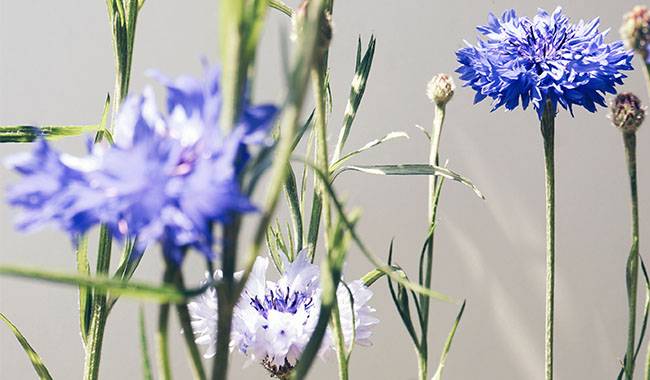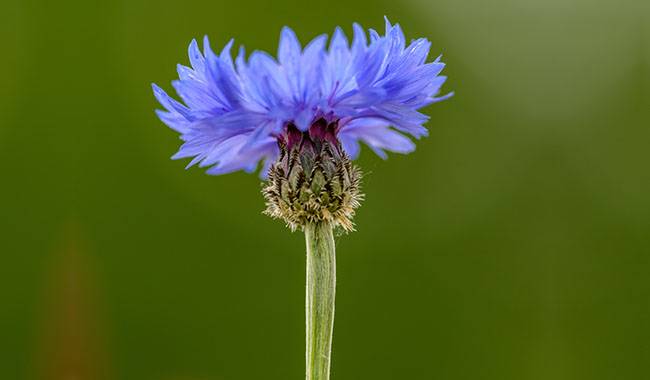
Do you want to decorate your garden or garden plot with colorful and bright flowers that will delight you for years and decorate everything?
Cornflowers: Growing from seed, when to plant them and how? You will understand more about how to growing it and take care it in this article.
INFORMATION AND CHARACTERISTICS OF CORNFLOWER
Cornflower is a genus of herbaceous plants in the Asteraceae family. Their history began as a common weed in fields where rye was sown.
People fell in love with the plant for its unusual and beautiful flowers, and it has been cultivated since about the mid-16th century. Since then, many varieties have been cultivated, ranging from dwarf specimens to giants about 31inch (80cm) tall.
Cornflower (Latin Centaurus, from the Greek Κένταυρος) is a plant with an unusual history.
According to mythology, its name comes from the fact that the Centaurus (the son of Kronos and Phylaera, who was immortal) was cured by it of the venom of the Lernaean Hydra (the daughter of Typhon and Echidna, later killed by Hercules).
Although the name Centaurus has been known since ancient Greece, all plant names approved before May 1, 1753, are considered invalid according to the International Code of Botanical Nomenclature. And the official authorship belongs to Carl Linnaeus.
The flower may have been commonly known as bobylnickum, perepoloshok, voloschok, or synetsvetok.
In our time, we know about 550 species of cornflowers growing in the territories of Europe, America, and Asia.
The classic flower of this family is the cornflower frost mix, which is unpretentious, has a variety of colors, and grows to 31inch (80 cm).
PROPAGATION METHODS OF THE SPECIES
Like most cultivated flowering plants, cornflowers are divided into annuals and perennials. Annual cornflowers are mainly grown from seed, while perennial cornflowers are mostly transplanted. Gardeners prefer perennial varieties that can grow in the same location for up to 10 years.
THE VARIANTS OF CORNFLOWER ARE CLASSIFIED AS
Arid plants
Prairie varieties are accustomed to hot and dry climates. Arid plants include blue cornflower, musk amber, etc. Dry plants have a large number of primary roots that are able to penetrate deep into the soil in search of moisture.
Neutral plants
More delicate meadow flowers that prefer slightly moist soil. The flowers in this group are mainly annuals: Cornflower Lugovoy, Myagky, Phrygian, etc. It is recommended to make the soil in which these species grow neutral in acidity.
TO GROW SEEDS IN THE OPEN GROUND
- The soil must be loosened and the seed holes punched at a depth of about 0.6inch (1.5cm).
- The distance between holes for larger species is 2-4inch (5-10 cm) – at this distance, the flowers will support each other as they grow.
- For undersized varieties, it is recommended to keep 8inch (20 cm) between the holes – undersized varieties tend to clump and grow in width.
If the bushes do not have enough room to grow, they will begin to degenerate, the stems become thinner, and the buds become smaller and fade.
SITE SELECTION AND SOIL PREPARATION
There are several basic conditions to consider when selecting a seeding site.
In their natural environment, wild cornflowers grow in open fields and do not need the protection of the hot sun. The area on the plot where they are sown should be open and preferably free of shade.
When choosing a location, also take into account the great variation in height and size of the different species. Tall specimens are usually planted behind the bed, while low specimens are used for decoration or planted in front of taller ones.
Cornflowers are colorful and colorful in their own right, and if they are placed among other such multi-colored varieties, the beds can look a bit confusing. They are best when combined with plain colored flowers.
For a complete landscape design, it is recommended to choose seedlings with a monochromatic background. Green shrubs or hedges will work well.
All varieties of cornflowers are fairly plain flowers that will grow in any soil. However, if you fertilize the soil, the flowering time will be a little earlier and will be significantly lusher.
SOWING TIME
You can plant cornflower seeds in the spring, sometime in August, or in the fall. Spring plantings will send out their first shoots in a few weeks, but will not bloom until the following summer.
This is typical for both annual and perennial varieties. Therefore, it is best to plant in the fall.
HOW TO GROW CORNFLOWERS
Since cactus is a stem-rooted flower, soil that is too loose should be tamped down slightly to make it denser before planting.
Otherwise, if there are many voids in the soil, the roots may not be able to grip and the flowers will not develop well. It is almost written above to loosen the soil, but this only applies to its upper layer to prevent water from accumulating after watering and to ensure that air enters the roots.
The principle of sowing cornflower annuals and perennials is the same, the only difference being that annuals are flowers that grow from seed all the time, while perennials grow only from seed, the first time they are planted, and then replanted later.
At the end of the flowering period of an annual, a seedpod matures in place of the flower bud and can be collected. Store the seeds in a dark, dry, cool place, preferably in a ceramic container, and dry them occasionally.
In this way, the seeds can be collected for replanting for 3 consecutive years, after which the germination rate begins to decline.
Sunlight
Cornflowers not only like sunlight, but they also tolerate heat and drought very well. In addition to not planting them in the shade, it is best to place these flowers in the shade so that other plants do not shade them either.
Lack of sunlight is detrimental to the growth and flowering of cranesbills, as well as making them weaker and more susceptible to disease.
Fertilization
Fertilize the flowers during the formation of flower buds. Fertilization is well suited to urea: 20 grams of fertilizer diluted in 10 liters of water. The consumption of fertilizer solution for watering is about 3-4 liters per 1 square meter of bed.
There is an even stronger product that can be used in combination with other fertilizers: growth preparations. The growth preparation is diluted at a rate of 1 ml per 1 liter of water and sprayed on the flowers shortly before bud formation. One liter is enough to treat an area of about 30 square meters.
Watering
Cornflowers do not like standing water and must be watered in moderation; over-watering can kill the plant. If watering is followed by standing water, the topsoil can be gently loosened. Some varieties need only a little water, others need more – know your variety before planting.
Pruning
To take care of the bed and make it look neat and tidy with each new season, cut back any wilted stems at the end of the flowering season. This has no effect on the plant itself, just for aesthetic purposes.
Also, in the case of perennials, after a few years, old shoots can pile up tremendously in the bush, making any interaction with it difficult.
HOW TO GROW SEEDLINGS

How to grow seedlings? Seedlings are planted mainly in the first half of April.
- Fill the container containing the seedlings with soil and tamp it slightly (as in the case of in-ground planting).
- Make small holes of 0.4-0.8inch (1-2cm) in the ground and moisten them with water.
- Place the seeds in the holes and cover them with soil (the soil does not need to be compacted again).
- The seeds planted in the prepared container are wrapped with film to create a greenhouse effect.
- Store the container in a sunny place at a temperature of about 71.6°F (22°C).
- After germination, remove the film.
- Fertilize with a special seedling fertilizer (once).
- When the seedlings grow to 4inch (10cm), transplant them into the open ground. Cornflower does not respond well to transplanting, so it is best to transplant them together with the growing soil.
PROPAGATING RHIZOMES
Although perennials grow on their own, it is advisable to remove excess plants for them and transplant them regularly in order not to make them sick due to increased shrub density. This should be done in late summer, usually in August.
- Carefully dig up the adult shrubs with the soil so as not to damage the roots.
- Wash the roots out of the soil and place them in a convenient container: in a pot, bucket, etc.
- After washing, divide the large bush into several clumps so that each new bush has its own complete root system with several healthy buds and no less than 3 buds.
- Each of these bushes should be rooted so that its length does not exceed 4inch (10cm). This encourages the development of new plants.
- Further planting in the open ground is done according to the above principles: make a small hole in the ground, slightly moisten the soil in the hole with water, plant the plant in the resulting hole and cover it with soil.
If everything is done correctly, you can expect to have flowers next summer.
CORNFLOWER PESTS AND DISEASES
If all the few rules of care are followed, the flowers should not get sick. The most common disease that can affect cornflowers is Fusarium.
Fusarium is caused by the metamorphic ascomycete fungus Fusarium, which is similar to a mold in some way. The mycotoxins produced by these fungi during their life activities can destroy diseased perennials.
This disease can affect any part of the flower, but basically, all diseases start with yellowing leaves.
It is best to remove the infected area immediately, treat all flowers with a fungicide, and dust the flowers themselves as well as the soil in which the flowers are scattered.





